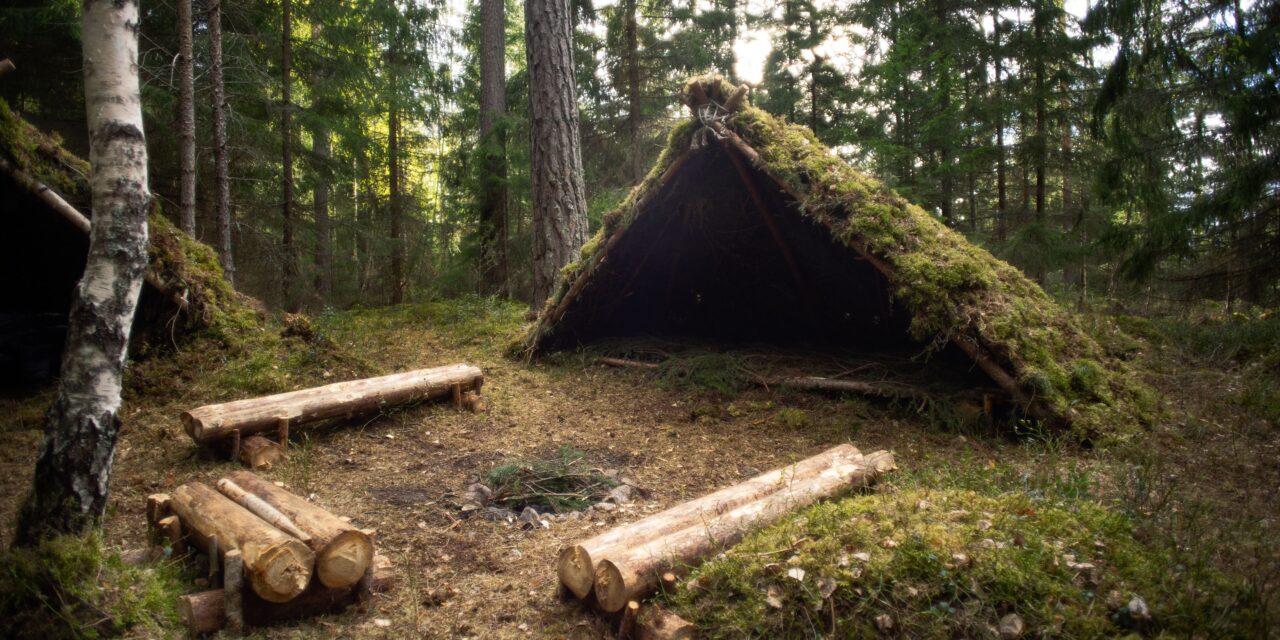The Importance of a Shelter in Survival Situations
Imagine you’re lost in the woods; the sun is setting, the temperature is dropping, and the wilderness is unforgiving. In such scenarios, a survival shelter isn’t just a place to rest—it’s a lifeline. Building an effective survival shelter in the woods is a fundamental skill for any outdoor enthusiast, hiker, or adventure-seeker. It’s not just about braving the elements; it’s about understanding and respecting nature’s power while harnessing its resources to ensure your safety and well-being.
In this comprehensive guide, we will delve into the essentials of constructing a survival shelter in the wilderness. Whether you’re a seasoned outdoorsman or a beginner setting foot into the realm of survival skills, this article will equip you with practical knowledge and techniques to build a reliable shelter. Remember, in the wild, a shelter is more than just a roof over your head—it’s your sanctuary against the unpredictability of nature.
Building a survival shelter requires more than just physical effort; it demands mental resilience and a strategic approach. The key lies in understanding the environment, choosing the right location, and using available materials effectively. This article will walk you through these crucial steps, offering expert insights and tips to enhance your survival skills.
Let’s embark on this journey of survival wisdom, where we learn to harmonize with nature, leverage its offerings, and emerge as adept survivalists. By the end of this guide, you’ll have a deeper appreciation of the outdoors and the confidence to face wilderness challenges with composure and skill.
Next, we will explore various types of survival shelters, materials you can use, and step-by-step instructions on constructing your woodland haven. Stay tuned as we dive deeper into the world of survival shelters.
Remember, the ability to build a shelter could mean the difference between a life-threatening situation and a story of survival against the odds.
Types of Survival Shelters and Construction Techniques
Survival in the wild hinges on your ability to adapt to the environment and use available resources efficiently. In this section, we explore different types of survival shelters suitable for various landscapes and weather conditions. Understanding these will empower you to make informed decisions based on your specific situation in the woods.
1. Lean-to Shelter
A lean-to shelter is one of the simplest and most effective structures you can build. It involves leaning branches against a sturdy horizontal support, such as a fallen tree or two forked branches. Start by securing the horizontal support between two trees. Then lean long branches against it at an angle to create a wall. Cover this framework with smaller branches, leaves, and other insulating materials to shield yourself from wind and rain.
2. A-Frame Shelter
Resembling the shape of the letter ‘A’, this shelter is excellent for retaining heat and repelling rain. Construct it by forming a simple frame using two long sticks as the sides and a shorter one as the ridgepole. Cover the frame with foliage, bark, or other available materials. The A-frame is compact and ideal for body heat retention during cold nights.
3. Debris Hut
This shelter is similar to the lean-to but provides more coverage and insulation. Build a sturdy frame using branches and cover it completely with leaves, moss, and debris. Ensure the insulation is thick enough to provide warmth. The debris hut is particularly effective in colder environments where heat retention is crucial.
4. Snow Cave
If you’re in a snowy environment, a snow cave can be a lifesaver. Dig into a deep snowdrift, hollowing out a space large enough to accommodate your body. The snow itself acts as an excellent insulator. However, be sure to create a small ventilation hole to avoid suffocation.
5. Tarp Shelter
If you have a tarp or a large waterproof material, it can be used to create various shelters like a tarp lean-to or a tarp tent. Use trees or branches to support the tarp and secure it to the ground. A tarp shelter is quick to set up and highly effective in rainy conditions.
Construction Techniques and Tips
- Location is key: Choose a site that’s flat, dry, and away from natural hazards like falling branches or flooding areas.
- Insulation: Use leaves, grass, or even your spare clothing to insulate the ground. This will help retain body heat and protect you from the cold earth.
- Waterproofing: Make sure your shelter repels water effectively. If using natural materials, layer them like shingles on a roof.
- Size: Build the shelter just big enough for your body. A smaller space is easier to heat and maintain.
- Ventilation: Even in cold conditions, proper air circulation is crucial to avoid condensation and ensure a supply of fresh air.
Building a survival shelter in the woods is not just about brute strength; it’s about ingenuity and making the most of your surroundings. In the next section, we will summarize the key takeaways and provide additional insights for effective wilderness survival.
Remember, your shelter is more than just a structure; it’s a testament to your resilience and ingenuity in the face of adversity.
Summary and Takeaways
Survival in the wilderness is a testament to human resilience and adaptability. In this article, we’ve explored the critical skill of building a survival shelter in the woods. Here, we summarize the key points and offer final thoughts to guide you in your wilderness adventures.
Key Takeaways:
- The Importance of Shelter: A survival shelter is crucial for protection against the elements, be it harsh sun, wind, rain, or snow. It also provides psychological comfort, a vital aspect of survival.
- Types of Shelters: Depending on your environment and available resources, you can choose from various shelters like the lean-to, A-frame, debris hut, snow cave, or a tarp shelter. Each has its unique advantages and suitability based on the conditions.
- Location Selection: Choose a safe, dry, and flat location for your shelter, away from natural hazards. The site should also be close to resources such as water and firewood but not in an area prone to flooding or falling trees.
- Construction Techniques: Effective construction hinges on proper insulation, waterproofing, and ventilation. The size should be just enough to fit your body to retain heat efficiently.
- Resourcefulness and Adaptability: Use available natural materials and any gear you have, like tarps or ropes. Remember, the best tool you have is your ingenuity.
Building a survival shelter is a fundamental skill for anyone venturing into the wilderness. Whether you’re a seasoned outdoor enthusiast or a beginner, knowing how to create a safe and warm shelter can make a significant difference in a survival scenario.
Remember, the ultimate goal of survival is to stay safe and get back to civilization. Your shelter is not just a physical structure; it’s a morale booster, a place where you can gather your thoughts, rest, and plan your next steps.
“In survival, the game is won by keeping your head. Your shelter becomes your sanctuary, your fortress, your home away from home. Respect it, invest in it, and it will serve you well.”
Final Thoughts
Survival in the wilderness is as much about mental strength as it is about physical skills. Knowledge, resourcefulness, and a calm, composed mind are your greatest assets. Always be prepared, stay informed, and respect nature’s power.
As you venture into the wild, carry these lessons with you. Let them be your guide as you navigate the challenges of the wilderness. And remember, the skills you acquire in the process are not just for survival; they enrich your understanding of nature and your place within it.
Stay safe, stay prepared, and embrace the adventure that awaits in the great outdoors.








